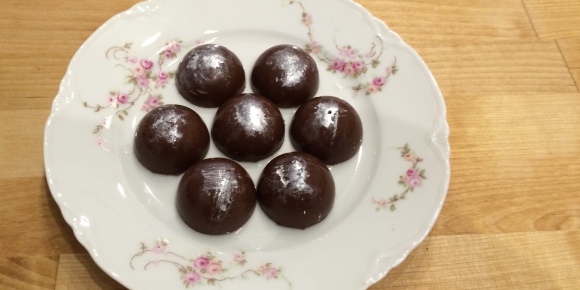
There’s a common saying out there concerning the manufacturing of sausages. It implies that once someone learns about the intestines, guts and other general all-around yuckies that go into something as wonderful as a sausage, that our newly graduated sausage scholar friend will lose his or her appetite for the very sausage he or she just studied.
As it turns out, that saying really doesn’t apply when it comes to chocolates.
I’d never taken a ton of time to consider how the truffles, bonbons and other filled chocolates are made, but given how much Mister Rogers’ Neighborhood I watched as a kid, I kind of generally assumed the process was a lot like how people make crayons or macaroni: mostly using big machines, with some oversight by men wearing hats and distribution by means of Mr. McFeely.
That in mind, when my friend and noted chocolatier Chef Amanda Tommey Terbush told me that she was getting ready to make some bonbons to sell during Valentine’s Day weekend at her Southern France Patisserie*, I was intrigued, as her kitchen featured neither big machines nor Mr. McFeelies. [Ed. note: I can’t say one way or another about hats.] Immediate further investigation revealed my preconceptions were woefully inaccurate and that I actually had no idea how one creates a bonbon; for the benefit of my vast readership, Amanda was kind enough to invite me to observe her make a batch.
*[Ed. note: Southern France Patisserie is a hybrid French and American Southern bakery on Irving Park and Southport just north of Wrigley Field. It’s a perfect place to eat pastries, drink coffee and complain about Mizzou football, and has become one of my favorite spots in the whole city. If you find yourself free on a Friday, Saturday or Sunday morning, mosey on over and give literally anything a try; there’s a more than 50 percent chance you’ll giggle at how good it is.]
Constructing a Bonbon
When I arrived, Amanda was already hard at work, having already completed batches of milk chocolate/Tahitian vanilla bean ganache and white chocolate/strawberry champagne ganache bonbons [Ed. note: Scroll to the bottom for tasting notes]; I was going to watch her make a dark chocolate variety, which would be filled with a blood orange salted caramel ganache, because of course it would.
The first step of creating one of these confections is to create the outer shell of the bonbon. Amanda had already taken care of this at the time, with racks upon racks of dark chocolate shells already cooled and ready to be filled.
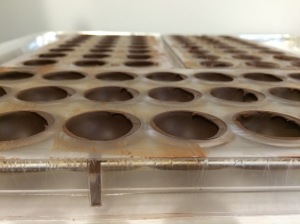
Racks on racks on racks.
Now, just about anybody would see that rack and get excited, but Amanda made sure to note to look more closely to ensure that everything was going according to plan. Perhaps the most important thing to look for at this point is the shine and coloring of the chocolate shells. If it’s shiny and uniform throughout, it means that the chocolate was tempered at the right temperature; this chocolate will taste wonderful and “crisp” when it breaks. However, if it was tempered improperly, the chocolate will demonstrate “blooming”: streaks of lighter brown interspersed with the darker chocolate.
Have you ever had a candy bar that totally melted and you tried to save by putting it in the freezer, and when you pulled it out and opened it, it mostly looked the same save some lightish stuff on the outside? That’s bloom.
Bloom is evidence that the chocolate was tempered at the wrong temperature; the fat from the cocoa butter does not emulsify with all of the chocolate and separates. This will lead to imperfections in the mouthfeel and cleavage of the chocolate, a major bummer for all involved. No “crisp”, no glory.
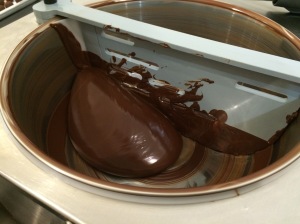
Chocolate tempering in a tempering machine, called, what else, a Choc-o-vision. [Ed. note: This chocolate would later be used on truffles, but demonstrational purposes, yo!]
Unsurprisingly, these shells were a florist’s biggest nightmare and demonstrated no bloom at all [Ed. note: *looks around*], so now that they were cooled, Amanda could begin preparing the filling, which will eventually be piped into the shells (once the filling itself cooled) and sealed up with a bottom layer of chocolate.
To make the ganache, Amanda started by heating a cream and blood orange zest mixture on an induction burner — the technical term for the equipment, as opposed to “little cooky heaty stove” — to activate the oils in the orange rind and unlock the flavor.
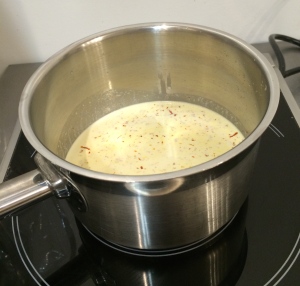
The red specks are the orange rind, and the yellowy appearance on top of the cream is the extracted orange oil.
Once the cream mixture is appropriately warmed, Amanda set it aside and strained out the orange zest pieces. From there she created a quick caramel using the very same induction burner, then slowly introduced the orange cream to infuse the two.
You know when you were in grade school and you watched your parents make a baking soda and vinegar volcano for you for science class? Remember that reaction? That’s kind of like what combining the cream and the caramel is like, except instead of sourness and learning, this smelled like orange-tinged angels out for a romp on the town.
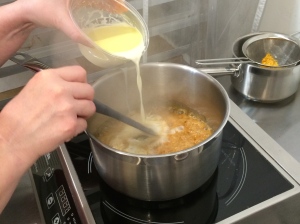
Bubblin, steamin, hissin.
The very, very hot caramel reacts with the much cooler cream mixture, which creates a slightly violent reaction — many bubbles and hisses and steams are had — so Amanda stressed the importance of introducing the cream slowly. She emptied the container of orange-infused cream in four to five pours, and from there mixed everything into a beautiful orange-caramel soup.

Prepped bowl of chocolate baking chips, salt and glucose.
Amanda then poured the orange-caramel mixture into an already-prepared bowl of chocolate, salt and a little glucose (a syrup that to the lay person’s eye is very similar to corn syrup, which affords a creamier ganache texture). The result? A treacly, primordial soup of chocolate, caramel, orange and friendship.

Amanda grabbed her hand mixer, looked at me and lit up.
“This part will never get old to me,” she said. “You have this bowl of nothing. And it’s nothing, it’s nothing … then all of the sudden, it’s the most beautiful, delicious thing you’ve ever seen.”
She started mixing, and, well … she was right.
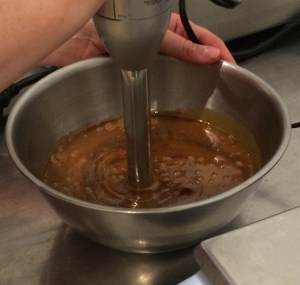
Nothing …
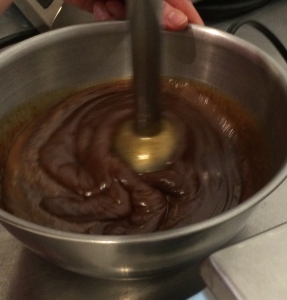
… nothing …

… Something.
The end result was a silky, thick ganache that passed the taste test: the first thing to hit the tongue is the flavor from the caramel, which melts into the notes of the blood orange (which can many times be on the more caustic side, but this orange was gentle and benevolent), which gives way to chocolate and a finishing tap on the shoulder to remind you that yeah, there WAS a pinch of salt in there. [Ed. note: You’re damn right I giggled.]
The deed was done, there was nothing left to do outside of let the ganache cool overnight to pipe into the dark chocolate shells and seal up. This process can’t really be rushed, a as chocolate is actually a good insulator of heat (likely as a result of its fat content). Piping ganache into the shells at too high a temperature could cause bloom within the bonbon, which nobody wants, or even an improper crystallization of the ganache itself.
Have you ever bitten into a chocolate to reveal a watery solution was waiting on the inside with whatever filling you were expecting? That’s a sign that either the filling was too hot when it was added, or the bonbon was sealed up before it had completely cooled. The more you know!
Tasting Notes
I wasn’t able to try a completed dark chocolate/blood orange salted caramel ganache bonbon, but, having tried all the ingredients within it, I can say that it’s pretty darned good, and this is coming from someone who’s not the biggest fan of the chocolate-orange flavor profile.
Also, given the dichotomy of how people enjoy chocolate (the chewing v. holding corollary), I asked Amanda how she recommended enjoying a bonbon. Do you go whole hog, bite right into that sucker and chew away? Let it melt like an M&M until the shell is completely dissolved?
Naturally, her answer was somewhere in between: You certainly want to bite into it, but hold it in your mouth for a few seconds to let the outer shell of the bonbon soften, then chew away. That way, the entire flavor profile will be allowed to develop within your mouth and you’ll get the experience the chocolatier intended.
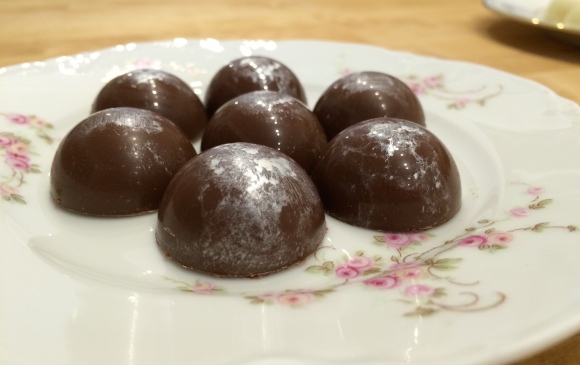
Milk chocolate/Tahitian vanilla bean ganache
In my research, I noticed that Amanda always went out of her way to note that she was using vanilla beans from Tahitia instead of the regular ones that are probably grown somewhere less exotic than Tahitia like California or Indiana. I inquired as to the difference, and Amanda let out a string of joyful expletives that she wouldn’t let me reprint in this space, so I’ll paraphrase by saying that Tahitian vanilla beans have a deeper, more complex flavor profile than a typical vanilla.
[Ed. note: Yes, I know it’s Tahiti.]
That flavor profile came through in spades in this this bonbon, as the silkiness of the milk chocolate shell gives way to the floral notes of the Tahitian vanilla filling. The vanilla almost tickles the back of the nose as it works its way across your palate, and is just the most fantastic thing.

White chocolate/strawberry champagne
I’m usually bearish on white chocolate treats, but there’s no question what the star of this show is: that dadgum ganache. It just sort of dances in your mouth, with a custardlike texture that underlies the fun and lightness of the strawberries and champagne. The white chocolate taste is there, but it’s complementary, in a way where it wants you to know it’s there but also that it’s not doing all it can do — somewhat like a break dancer who goes to a wedding as his girlfriend’s plus-one and doesn’t want to attract too much attention, so he just dances well instead of stealing the show.
***
A huge, huge thank you to Chef Amanda and the Southern France Patisserie for letting me see how the sausage is made. Go, buy all of her pastries. Now.

This was a fun read. Maybe you should take more field trips!
A question…….what is the metallic-like appearance on the milk chocolate/Tahitian vanilla buggers?
LikeLike
That’s a confectioner’s powder called Lustre Dust! Great name.
LikeLike
Enjoyed reading your informative article! I could taste the bonbons from your descriptions.
LikeLike